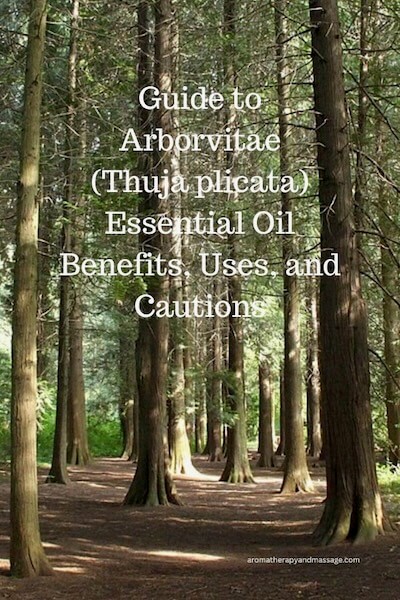- Home
- Essential Oil Profiles
- Arborvitae Essential Oil
As an affiliate for Bookshop, Amazon, and other programs, I may earn a small commission for products purchased through links. This doesn't affect the price you pay. Privacy policy and disclosures.
Search this site:
Guide to Arborvitae Essential Oil Benefits, Uses, and Cautions
Arborvitae essential oil is an alternative name for Thuja plicata oil that's steam-distilled from the heartwood of the tree, also called western arborvitae, western red cedar, pacific red cedar, or giant arborvitae.

Another Thuja plicata oil is steam-distilled from the needles/leaves of the tree. It's often called western red cedar or thuja essential oil but might go by any of the other names mentioned.
Also available is Thuja occidentalis oil, steam distilled from leaves, twigs, and bark of a tree that's also called eastern arborvitae, northern white cedar, eastern white cedar, white cedar, swamp cedar, cedar leaf, or thuja cedar leaf.
Many sources recommend use of Thuja plicata leaf oil and Thuja occidentalis oil only by experienced aromatherapists due to the high content of thujone, which is potentially neurotoxic.
Caution: Look at the Latin name and method of production of an essential oil to know what you are buying.
Basic Arborvitae and Thuja Facts
Plant family: Cupressaceae. (Although the tree is often called a cedar, thuja belongs to the cypress family.)
Aroma:
- Arborvitae: Deep and earthy, with sweet and spicy undertones.
- Thuja plicata leaf oil: Coniferous, fresh, camphoraceous, slightly sweet.
- Thuja occidentalis: Woody, fresh, camphoraceous, slightly sweet..
Perfume/Aromatic note:
- Arborvitae: Base.
- Thuja plicata leaf oil: Top.
- Thuja occidentalis: Middle.
Source for aromas and notes: Lotus Garden Botanicals1
Is arborvitae safe to use during pregnancy and breastfeeding? No, do not use any of the thuja oils, according to multiple sources.
Is arborvitae or thuja essential oil safe for children? No.
Main components of Thuja occidentalis:
- alpha-thujone 48.7–51.5%
- fenchone 12.2–12.8%
- beta-thujone 7.9–9.9%
Main components Thuja plicata distilled from the needles/leaves:
- alpha-thujone 63.5–84%
- beta-thujone 4.9–15.2%
- sabinene 1.18.8%
Source: Essential Oil Safety, 2nd Edition. The book recommends a dermal maximum of 0.4% for Thuja occidentalis and 0.25% for Thuja plicata leaf oil.
The book does not give the components of arborvitae, as it's a relatively newly available essential oil. Doterra lists the main chemical components of arborvitae as methyl thujate, methyl myrtenate, and alpha-terpineol.
Arborvitae Essential Oil Benefits and Uses
Lotus Garden Botanicals: Arborvitae essential oil is grounding and calming, strengthens the senses, and cleanses and purifies the air.
Revive Oils: Arborvitae improves skin health and keeps bugs away. Diffuse the oil or dilute it and apply to wrists and ankles for a natural bug repellant. The oil's antiseptic properties make it useful in DIY cleaners.
Doterra: Arborvitae oil is a powerful cleansing and purifying agent. Diffuse it or use it to make a room spray. Also diffuse the oil to inspire feelings of peace and calm. Possible skin sensitivity.
Woody Diffuser Blend
- 2 drops arborvitae
- 2 drops sandalwood essential oil
- 2 drops cedarwood essential oil
Woodsy Roll-On Cologne (5% dilution)
- 3 drops arborvitae
- 3 drops sandalwood essential oil
- 4 drops frankincense essential oil
- Jojoba oil
- 10-ml roller bottle
Add essential oils to the roller bottle. Fill bottle with jojoba oil and insert the roller ball. Roll onto wrists, chest, and shoulders.
Source: Loving Essential Oils
Thuja Plicata Leaf Oil
Mountain Rose Herbs suggests blending Thuja plicata leaf with these essential oils for use in a diffuser or inhaler:
- To ease seasonal respiratory issues: sweet marjoram and ginger.
- To relax: sweet orange, cedarwood, and vetiver.
This oil is beneficial to the skin. To use combine with a carrier oil and geranium or helichrysum essential oil, remembering the noted dermal maximum of 0.25%.
Thuja Occidentalis
Thuja occidentalis "contains the skin irritants thujene and thujone and should be used externally for only short periods of time, and not by anyone prone to seizures. Thuja helps relieve pelvic congestion, enlarged prostate, urinary infections, and warts," states Aromatherapy: A Complete Guide to the Healing Art.
To use thuja to remove warts, rub a ring of vegetable glycerin around the wart and apply only one drop of essential oil to the wart itself, suggests 375 Essential Oils and Hydrosols.
To remove warts and skin tags, Original Swiss Aromatics recommends diluting thuja with a fatty carrier oil. To eliminate hardened mucus, make an inhaler with thuja—you can create blends that include other mucus-loosening oils such as eucalyptus, ravintsara, myrtle, or ho.
Nature in Bottle: Thuja essential oil relieves congestion and eases breathing and may help relieve chronic skin conditions such as acne, psoriasis, and eczema (caution advised for skin use—work with an expert). Thuja is also an insect repellent. Emotionally and energetically, the oil helps cleanse mind, body, and spirit, especially reducing negative emotions, and may also stimulate mental focus and help relieve exhaustion.
1Lotus Garden Botanicals source pages:
- https://www.lgbotanicals.com/Cedar-Leaf-Western-Red-Thuja-Essential-Oil-_p_1131.html
- https://www.lgbotanicals.com/Cedar-Leaf-White-Thuja-Essential-Oil-_p_1132.htm
- https://www.lgbotanicals.com/Arborvitae-Western-Red-Cedarwood-Essential-Oil-_p_1242.html
Buy essential oils from Aromatics International (recommended).
Rocky Mountain Essential Oils.
Photo Credit: Crusier, CC BY-SA 4.0, via Wikimedia Commons
